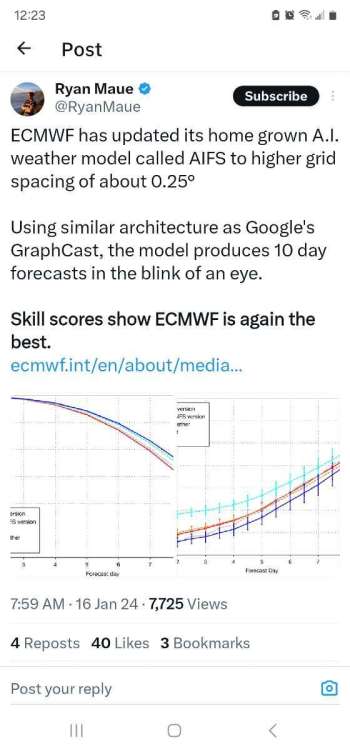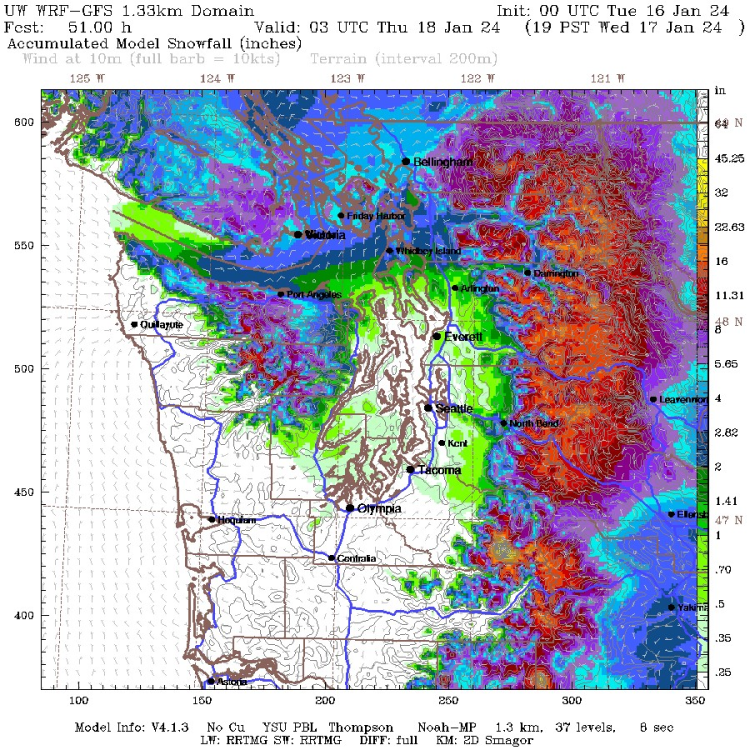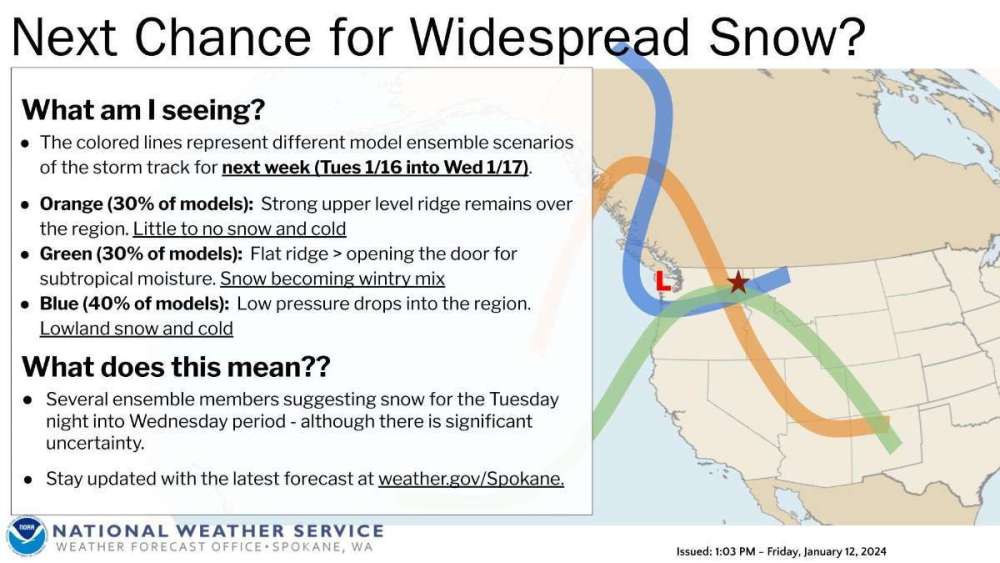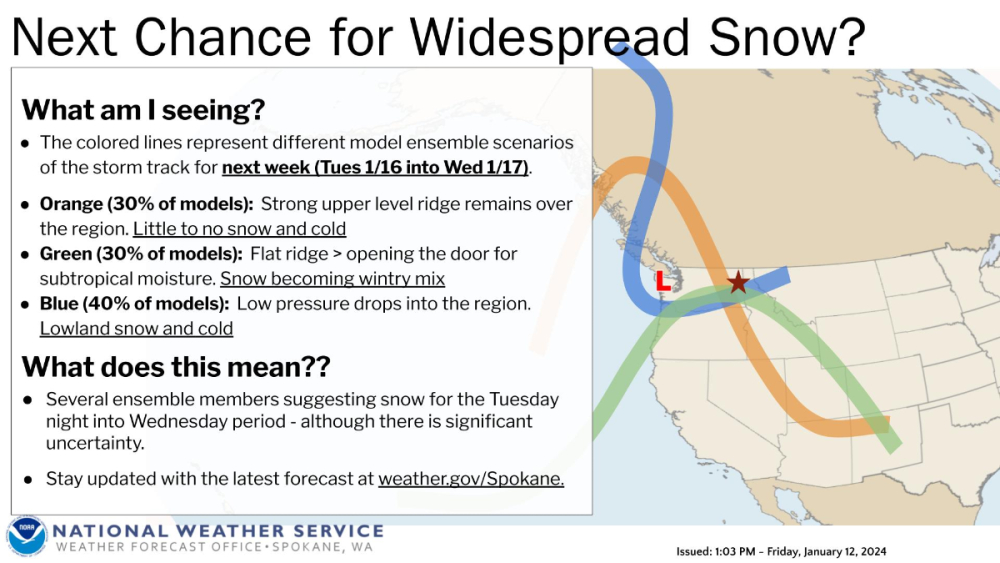-
Posts
3545 -
Joined
-
Last visited
-
Days Won
7
Everything posted by Brian_in_Leavenworth
-
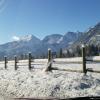
January 2024 Weather in the PNW (Part II)
Brian_in_Leavenworth replied to Meatyorologist's topic in West of the Rockies
I was disappointed in the 2/1/1989 event. Yes it got cold, one of the coldest events in Bellingham over the last 100 years. But hardly any snow. And within 5 or 6 days IIRC it was over. Temps back to normal. Later on, in early March, we had a good snowstorm and that was way more enjoyable. -

January 2024 Weather in the PNW (Part II)
Brian_in_Leavenworth replied to Meatyorologist's topic in West of the Rockies
This trick is probably safer. twittervid.com_BadWeatherKyle_714630.mp4 -

January 2024 Weather in the PNW (Part II)
Brian_in_Leavenworth replied to Meatyorologist's topic in West of the Rockies
I posted this earlier, but it's worth repeating. It's a graphic from NWS Spokane. Of course when they talk about snow they mean their forecast area. But it goes to show how the ensemble mean often doesn't tell the story. -

January 2024 Weather in the PNW (Part II)
Brian_in_Leavenworth replied to Meatyorologist's topic in West of the Rockies
https://x.com/BadWeatherKyle/status/1745947156115038533?t=mmyc3qqXAgAIL1LDXPMYpQ&s=09 -

January 2024 Weather in the PNW (Part II)
Brian_in_Leavenworth replied to Meatyorologist's topic in West of the Rockies
Of course the focus is on the upcoming event, but looking ahead a bit, next week has a lot of uncertainty. We all see the EPS or the GEFS, but that is an average and not necessarily an actual solution. NWS Spokane has a good graph illustrating the possibilities and the uncertainty. Keep in mind they of course forecast for Eastern WA and North Idaho, but the illustration is still helpful. -

January 2024 Weather in the PNW (Part II)
Brian_in_Leavenworth replied to Meatyorologist's topic in West of the Rockies
I've heard the lake temperature is warmer than normal for this time of year, though that probably won't last long. But the warmer water temps will certainly help with the snowfall. Could be epic. -

January 2024 Weather in the PNW (Part II)
Brian_in_Leavenworth replied to Meatyorologist's topic in West of the Rockies
Steelers-Bills game Sunday will be near blizzard conditions, according to FFWeatherGuys We have an Extreme Weather event shaping up for Sunday's Steelers @ Bills 1pm game. Near 30mph sustained winds with moderate-heavy snow will result in near-blizzard conditions for the duration of the game. You don't see #NFL playoffs games in blizzards often. -

January 2024 Weather in the PNW (Part II)
Brian_in_Leavenworth replied to Meatyorologist's topic in West of the Rockies
Maybe Friday night though, especially if the winds die down. -

January 2024 Weather in the PNW (Part II)
Brian_in_Leavenworth replied to Meatyorologist's topic in West of the Rockies
Speaking of mid next week, here is a good discussion from NWS Spokane regarding ensemble breakdown Keep in mind they forecast for Eastern WA and North Idaho There are some discrepancies as we head into Tuesday and beyond. The question becomes what happens to the ridge along the west coast. Does the ridge axis move east a bit and protect us, or will the axis remain along the coast and send waves down the front side of the ridge into eastern WA and north ID? By Wednesday there are 12% of the ensembles showing a deep trough moving in from the north, but that 12% is all European models. 33% keep the ridge strong, which is 90% of the GFS models. Then 36% show a broad flatter ridge and 19% showing some northwest flow and lower heights. Lots of potential scenarios. The basic idea is that temperatures will continue to moderate up towards average, but still be 5 to 9 degrees below average, and we will see an increased chance of snow starting Tuesday afternoon and continuing through the remainder of the forecast period. -

January 2024 Weather in the PNW (Part II)
Brian_in_Leavenworth replied to Meatyorologist's topic in West of the Rockies
6" and still snowing lightly in Leavenworth. 20 degrees currently. We had 9" Monday night and so far this winter between 45 and 50 inches. -

January 2024 Weather in the PNW (Part II)
Brian_in_Leavenworth replied to Meatyorologist's topic in West of the Rockies
Good. You know it's run 4x daily, and is usually different each time. And supposedly it is being discontinued soon. -

January 2024 Weather in the PNW (Part II)
Brian_in_Leavenworth replied to Meatyorologist's topic in West of the Rockies
Yes. It has spilled over into and past Leavenworth all the way to Wenatchee. We've had heavy snow for awhile, and temps are starting to drop into the 20s. -

January 2024 Weather in the PNW (Part II)
Brian_in_Leavenworth replied to Meatyorologist's topic in West of the Rockies
All of the above. And I love watching the snow fall, and the quietness after a snowstorm. Also the way that the evergreens are painted with snow the morning after a snowstorm. The deep blue skies above and the painted evergreen trees and mountains is a combination that can't be beat. I'm someone who really loves all the seasons. I love the fall colors, sunny Summer days with occasional (wet) thunderstorms, and seeing the green grass and flowers come back after the snow has melted. Though the time between the snow melting (usually in March) and the colors coming back is my least favorite time. -

January 2024 Weather in the PNW (Part II)
Brian_in_Leavenworth replied to Meatyorologist's topic in West of the Rockies
-

January 2024 Weather in the PNW (Part II)
Brian_in_Leavenworth replied to Meatyorologist's topic in West of the Rockies
Not that we should believe the GFS literally, but if the temps are that cold, qpf would be higher than it normally is for a Seattle snow. -

January 2024 Weather in the PNW (Part II)
Brian_in_Leavenworth replied to Meatyorologist's topic in West of the Rockies
Don't know about an entire winter, but for singular events, probably. Strong arctic fronts with strong winds will skunk Bellingham. 1989 is a classic example, and saw some of that with I think the 2nd arctic blast in December 1990. Meanwhile areas south got a lot of snow. -

January 2024 Weather in the PNW (Part II)
Brian_in_Leavenworth replied to Meatyorologist's topic in West of the Rockies
I remember a few years ago there was a news story about a proposal where forecasts were to be made at the national level, so that local mets would not be making the actual forecast, except when it is obvious it needs to be changed in the moment (I have seen that here in Leavenworth where it could have been rain or snow, and when it was snow, they made an adjustment in the forecast). This sort of takes away local knowledge, though in the AFDs they sometimes talk about pattern recognition I also wonder if this was pertaining not to the zone area forecasts, but the automated city forecasts. I have seen the automated city forecasts being completely different then the zone forecasts. A few years ago we had a WSWarning, zone area forecast for 6-8 inches of snow with highs in the mid to upper 20s, but the Leavenworth city forecast was for rain and a high of 43. Zone forecast was right, city was wrong. Don't know if it ever happened though -

January 2024 Weather in the PNW (Part II)
Brian_in_Leavenworth replied to Meatyorologist's topic in West of the Rockies
From what I've read, the NBM isn't simply taking every ensemble run and making a mean out of all of them. Nor does it "favor" one model over another or weigh one model over another. It sounds like it weighs all of them, but instead of a simple mean, it takes into account all known biases and tendencies of each model and then blends it all in. And over time it has improved, partly because models have improved, and partly because it better understands model tendencies and biases and better takes them into account -

January 2024 Weather in the PNW (Part II)
Brian_in_Leavenworth replied to Meatyorologist's topic in West of the Rockies
Interesting discussion from Pendleton NWS. Pretty technical, and I don't understand all of it. I am pretty much neutral in the Oregon vs Washington debate, since I get more snow than anyone in the forum from Washington or Oregon (A1Tahoe definitely gets more than all of us). I would love to see the northern solution, but would be happy for the Oregon posters if it goes there. Anyway . . . Guidance is in good agreement with the active pattern through the weekend before a respite arrives early in the workweek, but differences in the upper trough's strength and path arise regarding the Friday and Saturday systems. The GFS is weaker and more north for both systems, which pushes Friday's system more north into Washington and Saturday's system right through the Pacific Northwest. This provides a wetter, warmer, and windier outcome with the GFS than the ECWMF. These discrepancies are visualized via the 500mb EOF Patterns, which show a 50-60% ensemble variance regarding strength and location of both synoptic features. Analyzing both the cluster 500 mb heights and cluster phase space provides additional confidence in the GFS scenario as more ensemble members align with the GFS outcome and the deterministic solution is better represented by the ensemble mean. Thus, the NBM was utilized through the extended period to provide an appropriately weighted scenario, with the expectation of a slight trend to wetter/snowier conditions and warmer temperatures over future runs



